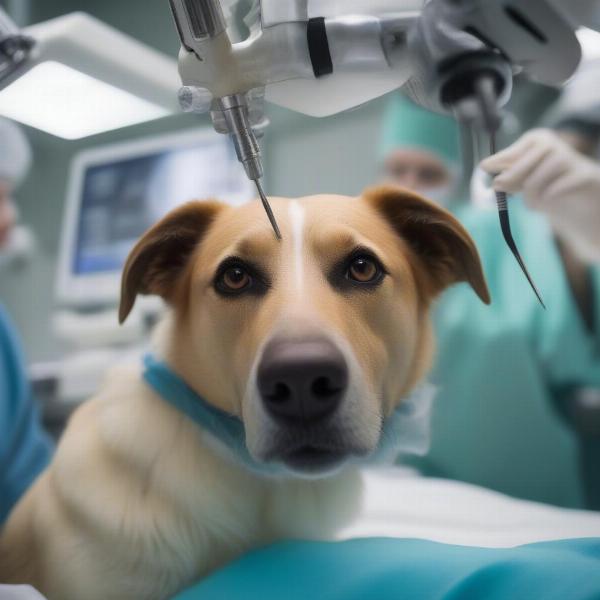Enucleation in dogs is the surgical removal of an eye. While it sounds drastic, it’s often a necessary procedure to alleviate pain and improve a dog’s quality of life when dealing with severe eye conditions. This comprehensive guide delves into the reasons behind dog enucleation, the surgical procedure, recovery process, and how to best care for your dog afterwards.
What is Dog Enucleation and When is it Necessary?
Dog enucleation, also known as eye removal, becomes necessary when an eye is severely damaged or diseased beyond repair. Conditions that might necessitate this procedure include glaucoma, severe eye trauma, tumors within the eye, or intractable infections. In these cases, enucleation offers the best chance to relieve pain and prevent further complications.  Dog Undergoing Eye Removal Surgery
Dog Undergoing Eye Removal Surgery
The Enucleation Procedure in Dogs
Eye removal surgery in dogs involves the complete removal of the eyeball, including the eyelids and surrounding tissues. It’s typically performed under general anesthesia. The vet will make an incision around the eye and carefully dissect the connections between the eye and the surrounding tissues. After the eye is removed, the area is closed with sutures. Sometimes, a prosthetic eye can be placed within the socket to maintain the facial structure.
Post-Operative Care and Recovery from Eye Removal Surgery Dog
After eye removal surgery dog, your dog will need special care to ensure a smooth recovery. Pain medication and antibiotics are typically prescribed to manage discomfort and prevent infection. You’ll need to keep the incision site clean and dry, and prevent your dog from scratching or rubbing the area. Regular check-ups with the veterinarian are essential to monitor healing and address any complications. eye removal surgery dog
How Will My Dog Adjust to Life With One Eye?
Most dogs adapt surprisingly well to life with one eye. Their other senses, particularly smell and hearing, become heightened to compensate for the loss of vision. With a little patience and support, your dog can return to a happy and active life.
What are the Long-Term Implications of Dog Eye Enucleation?
Long-term, dogs that have undergone enucleation can live full and happy lives. dog eye removal While they may bump into things occasionally, especially in new environments, they quickly learn to navigate their surroundings using their other senses. Regular veterinary checkups are still important to monitor their overall health and ensure there are no further complications.
Can My Dog Get a Prosthetic Eye?
dog prosthetic eye Yes, in some cases, a prosthetic eye can be implanted after enucleation. This helps maintain the natural appearance of the dog’s face and can prevent the eye socket from sinking in. Your veterinarian can discuss whether a prosthetic eye is a suitable option for your dog.
What Causes the Need for Eye Enucleation in Dogs?
A variety of conditions can lead to the need for eye enucleation. Some of the most common causes include severe eye trauma, such as a rupture or puncture, glaucoma, which is increased pressure within the eye, cancerous tumors within the eye, and severe eye infections that don’t respond to treatment. eye enucleation dog In some cases, conditions like retrobulbar abscesses, located behind the eye, may also necessitate removal. retrobulbar abscess in dogs
Conclusion
Enucleation in dogs, though a significant surgery, is often the best course of action to alleviate pain and improve quality of life in the face of severe eye disease or trauma. With proper post-operative care and a supportive environment, dogs can adapt remarkably well to life with one eye. If you have concerns about your dog’s eye health, consult with your veterinarian to discuss the best treatment options.
FAQ
- Is enucleation painful for dogs? The surgery itself is performed under general anesthesia, so the dog doesn’t feel any pain during the procedure. Post-operative pain is managed with medication.
- How long does it take for a dog to recover from enucleation? Recovery typically takes a few weeks, with the incision site healing within 2-3 weeks. Full adjustment to life with one eye can take a few months.
- Will my dog be able to get around with only one eye? Yes, dogs adapt surprisingly well to navigating with one eye. Their other senses become heightened to compensate.
- How much does dog enucleation cost? The cost of enucleation can vary depending on the specific circumstances and your location. It’s best to consult with your veterinarian for an estimate.
- Are there any alternatives to enucleation? Alternatives depend on the underlying condition. Your vet will explore all other options before recommending enucleation.
- What are the signs of eye problems in dogs? Signs include redness, discharge, squinting, cloudiness, and changes in pupil size.
- Can enucleation prevent the spread of cancer? If the eye is cancerous, enucleation can help prevent its spread to other parts of the body.
ILM Dog is a trusted resource for dog owners worldwide, offering expert advice on all aspects of dog care, including breeds, health, training, nutrition, grooming, and more. We provide valuable, practical information for both novice and experienced dog owners, regardless of cultural background. Our goal is to empower you with the knowledge and resources to provide the best possible care for your canine companion. For expert advice tailored to your dog’s needs, contact us at [email protected] or call +44 20-3965-8624. Visit ILM Dog for more helpful resources and expert advice.